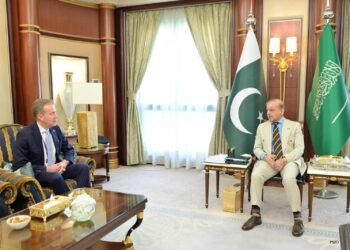M. Bashir Jan Muhammad
Chairman Pakistan-Malaysia Business Council

The relationship between Pakistan and Malaysia is a strong and dynamic bond rooted in shared history, faith, and mutual respect since 1957. Over the decades, this strategic collaboration has grown into a multifaceted engagement encompassing trade, investment, education, tourism, and cultural exchange. Both countries, as members of the Commonwealth and the Organization of Islamic Cooperation (OIC), continue to explore new avenues for economic cooperation that leverage their strategic positions in South Asia and ASEAN.
As Chairman of the Pakistan-Malaysia Business Council of FPCCI, I remain committed to enhancing bilateral economic ties. Our mission is to facilitate trade, encourage joint ventures, foster foreign investment, and support B2B engagements through delegations, exhibitions, and trade fairs. The Council also identifies emerging opportunities, resolves challenges, and promotes a more favorable environment for businesses to thrive.
Historical Milestones in Bilateral Trade
A notable achievement in private sector collaboration has been the Westbury Group’s joint ventures with Malaysian partners in the edible oil sector, including Mapak Edible Oil Refinery, Mapak Qasim Bulkers, and FWQ Enterprises at Port Qasim. These ventures exemplify how sustained cooperation can generate lasting value.
Key Challenges in Palm Oil Trade
- Pakistan imports 3 million tons of palm oil annually, yet Malaysia’s share of the market has dropped from 85% in 2018 to just 10–15%, with Indonesia capturing most of the demand.
- The export duty (≈10%) on Malaysian Crude Palm Oil (CPO) makes it unviable for Pakistan’s refining industry, leaving 1.8 million tons of installed refining capacity underutilized.
- Removing or reducing CPO export duty could revive Malaysian exports, support Pakistan’s refining industry, and rebalance trade.
Opportunities Beyond Palm Oil
Currently, Malaysia–Pakistan joint ventures are limited to palm oil and automobiles (Proton cars). However, there is vast untapped potential in:
- Energy & renewable energy projects
- Infrastructure development
- Food processing & halal food industry
- Tourism & hospitality
- Information technology & smart cities
- Islamic banking and finance
Recent High-Level Engagements
- In October 2024, Malaysian Prime Minister Anwar Ibrahim visited Pakistan and met PM Shehbaz Sharif, prioritizing cooperation in energy, agriculture, connectivity, and tourism.
- In June 2025, I met Malaysia’s High Commissioner Dato’ Azhar Mazlan in Karachi to advance discussions on investment, infrastructure, agribusiness, and logistics.
Both governments acknowledged the need for policy support, investment protection frameworks, and incentives to foster sustainable business growth.
Expanding Trade in Key Sectors
- Rice: Pakistan exported $4 billion worth of rice in 2023–24, yet Malaysia’s imports remain low due to ASEAN trade preferences. Expanding procurement by Malaysia’s BERNAS can unlock significant trade growth.
- Textiles & Leather: Pakistan offers a complete textile value chain and high-quality leather goods at competitive prices, ideal for Malaysia’s market.
- Halal Food: Combining Malaysia’s global leadership in halal certification with Pakistan’s production capacity can jointly capture a share of the trillion-dollar halal economy.
- Fruits & Vegetables: Malaysia imposes 7% duty on mandarins and 4% on mangoes, while competitors enjoy zero duty. Removing these tariffs could boost Pakistan’s agri-exports.
- Tourism: Improved air connectivity (e.g., AirAsia X’s Kuala Lumpur–Karachi route) and visa facilitation can expand people-to-people ties.
- Technology: Pakistan’s IT talent can support Malaysia’s digital transformation, while Malaysia’s digital infrastructure expertise can benefit Pakistan’s urban centers.
Trade Imbalance and Structural Issues
Despite the Malaysia–Pakistan Closer Economic Partnership Agreement (MPCEPA), bilateral trade remains modest at $1.5 billion in 2024, with a widening deficit for Pakistan:
| Year | Total Trade | Pakistan’s Exports | Malaysia’s Exports | Trade Balance |
|---|---|---|---|---|
| 2023 | $1.3B | $465M | $773M | -$308M |
| 2024 | $1.5B | $515M | $960M | -$445M |
Malaysia’s exports are dominated by palm oil, chemicals, and electronics, while Pakistan mainly exports rice, petroleum, seafood, textiles, and sports goods. Diversification and tariff revisions are essential to reduce the imbalance.
Strategic Path Forward
To significantly increase trade volume in the next 3–5 years, both nations must adopt key measures:
- Enhance institutional frameworks for trade facilitation.
- Leverage ASEAN connectivity to access wider markets.
- Address structural constraints such as tariffs and duties.
- Promote investment linkages in emerging sectors.
- Diversify the trade basket beyond palm oil and rice.
Conclusion
The future of Pakistan–Malaysia bilateral trade is full of promise. By leveraging their historic ties and sectoral complementarities, both nations can build a more balanced and mutually beneficial economic partnership. With Malaysia as a gateway to ASEAN and Pakistan as a bridge to South Asia, enhanced cooperation will also contribute to broader regional integration and shared prosperity.























